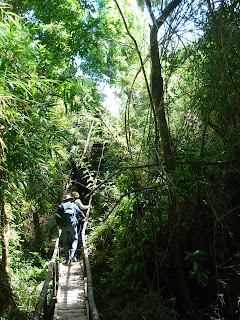The next stop on my tour of Chiloé island is the small
village of Cucao, about 25 miles north of Quellón and on the west coast of the
island. This view is from my room at Hostal Palafito Cucao, situated on the
bank the Cucao river and looking east at Cucao Lake.
There is excellent cazuela de vacuno (beef and
vegetable soup) in the green house across the Cucao River.
The Cucao National Park is a favorite destination for
many Chilean and foreign visitors. Many come for the day, and others come to
camp or stay in one of the many lodgings available. The above view is the
national park trail to the dunes and beach.
The lookout over dunes and
beach. This white sand beach is 15 miles long! Charles Darwin stopped by here
in the Beagle in 1835. From his journal of January 24:
“The
district of Cucao is the only inhabited part on the whole West coast of Chiloé.
It contains about thirty or forty Indians, who are scattered along four or five
miles of the shore, and without a single Spanish resident. — They are very much
secluded from the rest of Chiloé & have scarcely any sort of commerce,
excepting sometimes a little oil which they get from seal blubber. They are
pretty well dressed in clothes of their own manufacture, & they have plenty
to eat.”
Dunes and beach looking north
to Huentemó
Parrots feeding in a tree in
the national park.
A short walk inland takes visitors to the tepual, a
swampy area covered mostly in tepu trees (tepualia stipularia). A sturdy
boardwalk winds through the tepual and many signs help to explain this unique
ecosystem.
The tepual
View of Cucao Lake from a
lookout in the tepual.
On another day, Patricio
(Pato) is my guide to the dunes. I always prefer four sturdy legs under me, rather
then my questionable two.
Pato takes me into the hills
above the beach and park. This is looking south toward Pirulil.
View of Lake Huelde
Our return to Cucao after
about three hours on the trail. In another hour I will take a bus north to the
town of Castro, capital of Chiloé.


























































